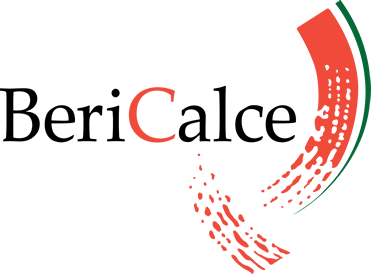Deprecated: The each() function is deprecated. This message will be suppressed on further calls in /web/htdocs/www.bericalce.it/home/wp-content/plugins/js_composer/include/classes/core/class-vc-mapper.php on line 186

COMPANY
History of Lime
Production
Lime is the most “antique” binder after gypsum and used until the industrialization of building. “Antique” like the Egyptians, Greek and Romans. The architects of Renaissance, among others also Andrea Palladio, describe it very well. Lime is obtained by heating limestone, composed mostly of carbonate of lime, at high temperatures. The limestone are reduced in pieces (if not already in pebbles), put into the furnace and calcine at 700-900 °C to become quicklime (oxide lime CaO).
Calcination of Limestone
Quicklime is a porous mass, so greedy of water to hydrate spontaneously if exposed to air. According to the quantity of impurity its colour vary from white to yellowish. For years two types of furnaces were used for the calcination of limestone: Batch furnace and continuous kiln.
Today rotary kilns are used.
Slake of Quicklime
The reaction develops a strong heat and the volume increases of approximately 10%. Due to the high temperature, that can be produced istantly (over 150 °C), the lumps swell, crumble and the water turns into vapour. Therefore, it’s necessary to add water a little at a time and mix the paste with care.
Setting and hardening of Lime
The main characteristic of lime is to compose a product that, when mixed with charges, results easy to work and mold until damp. Once dry, the product is quite water-resistant and has good mechanic properties as well as stability in time. This characteristic is based on a chemical reaction of slaked lime and carbon dioxide. While the mixture is drying, the water evaporates and forms carbonate of lime. This process is called “carbonation”: lime returns to the identical composition of the limestone but with very smaller crystals than in origin. The reaction of carbonation is very slow due to the low concentration of carbon dioxide in the air therefore the complete transformation of lime hydrate in carbonate needs even years. This is called “air” lime since it’s necessary the contact with air for setting. The evaporation of water causes a shrinkage of volume. For this reason slaked lime is never used alone but always with an inert charge to avoid breaking.
Types of Lime
Hydrated lime (Superfine Lime)
Obtained by using a quantity of water almost equal to the quantity of lime. The hydrate is a soft powder and finely separated. Sold in paper bags, like cement, and it must be kept in a well dry place. It’s less sensible to frost than grassello.
Lime Grassello
Obtained by using a quantity of water higher than the quantity of lime (approximate ratio 3:1). The Grassello becomes a plastic mass and oily at touch. In the past, rarely also today, the lime was slaked in holes in the ground where it was put under water for months (aging). It’s important to know that an insufficient slaking of limestone lumps, causes serious problems for mortar. The lumps slake later after use, increasing their volume and therefore creating swells and crumbles. Nowadays, grassello is sold packed in plastic bags, ready to use.

